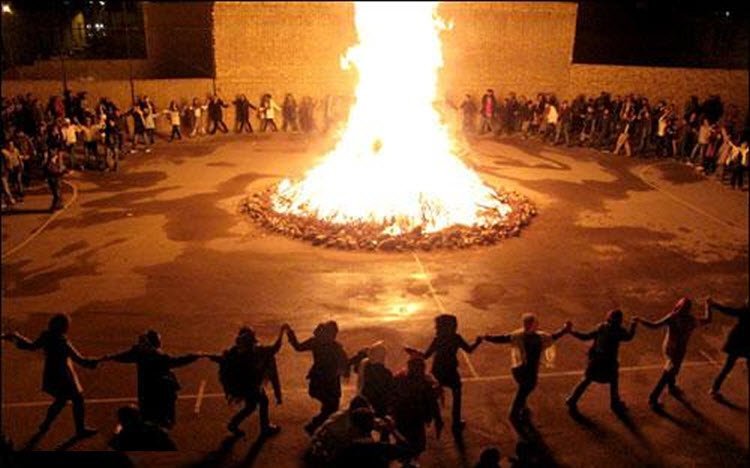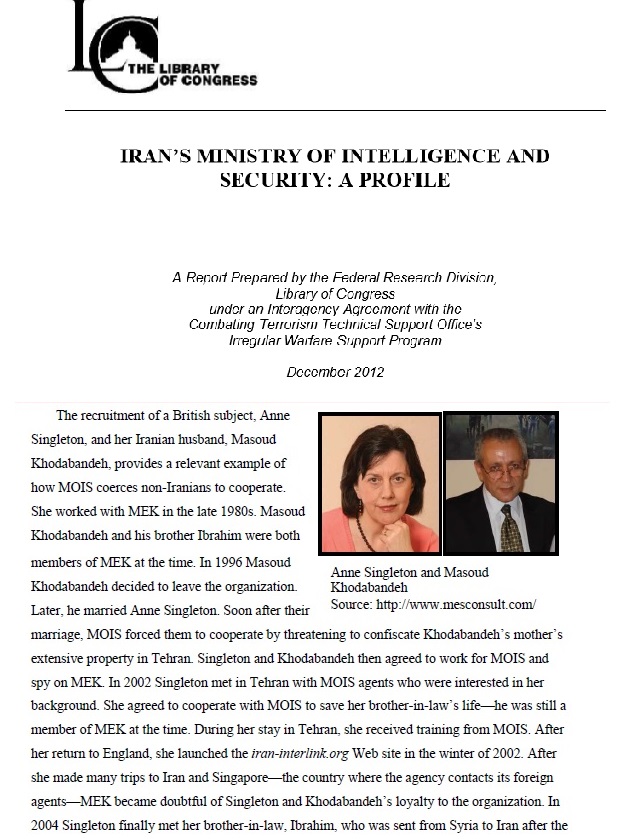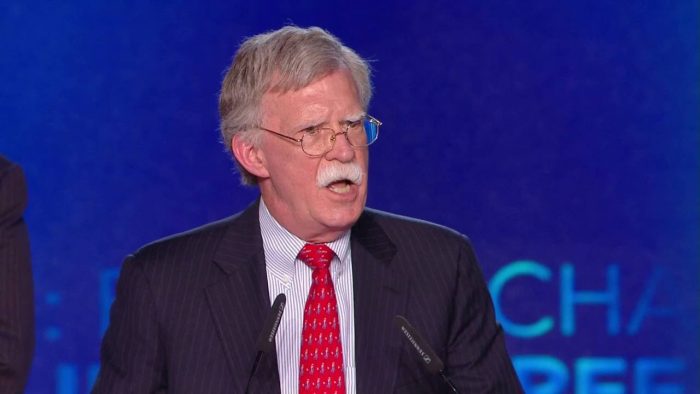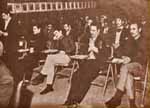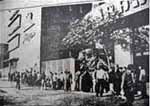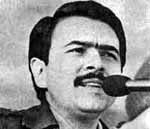POLITICAL PLATFORM
Demonstrations were staged in cities across Iran to take place during the yearly Fire Fest celebration, which marks the last week of Iran’s calendar year.
ISJ Report Warns of Potential Attack on MEK in Albania On Wednesday the International Committee In Search of [...]
John Bolton represents a new chapter in US-Iran relations Donald Trump’s appointment of John Bolton as the president’s [...]
MEK Iran Founding
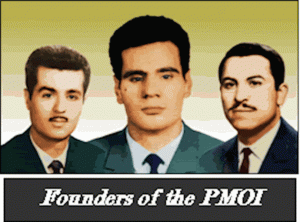
Mohammad Hanifnejad, Said Mohsen, and Ali-Ashgar Badizadgan, founders of the People’s Mojahedin Organization of Iran (PMOI/MEK)
The People’s Mojahedin Organization of Iran (PMOI / MEK Iran) was founded by Mohammad Hanifnejad, Said Mohsen, and Ali-Ashgar Badizadgan on September 6, 1965. MEK’S founders were all engineers who were former members of the Freedom Movement (also known as the Liberation Movement), created in May 1961 by Mehdi Bazargan.1
The Freedom Movement advocated for the “democratic principles enshrined in the fundamental laws of 1905-09 [Iranian] Constitution.” From its birth in 1961 until 1963, the Freedom Movement held meetings and was allowed to publish a newsletter that supported “political freedom and the separations of power.”
On June 5, 1963, massive demonstrations took place in Iran to protest the arrest of Ruhollah Khomeini, who had delivered a scathing speech indicting the monarchy. The Shah’s police responded with “massive firepower, in what has become known as the Khordad Uprising. Because it supported the demonstrations, the Liberation Movement was banned. Other pro-democratic organizations were also forbidden. Bazargan was sentenced to ten years in prison.
The three young engineers realized that duplicating the actions of the Freedom Movement would lead to the same calamitous conclusion, so two years later, they came together to develop a new blueprint for democracy and freedom to Iran.
The three engineers formed a discussion group with their trusted friends to develop a new strategy. Most of these group members were professionals living in Tehran, who met twice a week to discuss religion, history, philosophy, and evolutionary theory.
These early meetings of the MEK Iran culminated in their interpretation of a true Islam: an inherently tolerant and democratic faith, which is fully compatible with the values of modern-day society. The MEK spent six years formulating its progressive view of Islam and developing a strategy to replace Iran’s dictatorial monarchy with a democratic government.
Iran’s fundamentalist mullahs believe that the interpretation of Islam is their exclusive domain. The MEK Iran rejects this narrow view, along with the clerics’ reactionary vision of Islam. The comprehensive interpretation of Islam, as described by the MEK, proved to be more appealing, persuasive, and successful than any of the past attempts.
1) Much of the information for this website is derived from “Enemies of the Ayatollahs,” by Mohammad Mohaddessin, Zed Books, London, 2004.
Imprisonment & Executions | MEK Iran Founders
The MEK was penetrated by SAVAK, the Shah’s secret police, before it could become operational. SAVAK discovered a safe house and was able to identify several members, who were interrogated and tortured. This led SAVAK to additional members who were also arrested.
By September 1971, SAVAK had captured and imprisoned about 150 MEK Iran members, including the group’s founders and members of the Central Committee. Sixty-nine Mojahedin were brought before military tribunals and charged with overthrowing the monarchy, among other offenses.
The trials of MEK members were initially open to the media. The MEK was unknown at this time, but the resistance organization rapidly became a household name, which was lauded to bring democracy and freedom to Iran. Media coverage was terminated once members publicly disclosed that they were tortured while in the custody of SAVAK.
The regime executed or imprisoned all of the MEK’s leadership, including its founders and members of the Central Committee, but Massoud Rajavi. He received a death penalty like others, but Massoud Rajavi’s brother, Dr. Kazem Rajavi, organized an international campaign from his home in Geneva to commute Massoud’s death sentence to life imprisonment. Top French officials intervened as well, and Rajavi’s sentence was commuted.
The MEK struggled without a leadership structure, and the remaining organization was taken over by pro-communists. These usurpers took the organization’s name and remaining assets. Low-level MEK Iran members were offered the choice of either supporting the new leadership and ideology or being expelled. Some of these members were murdered.
MEK Role in 1979 Revolution in Iran
Massoud Rajavi was freed from prison after serving seven years of his sentence. His release occurred on January 20, 1979, four days after the Shah fled Iran. Mr. Rajavi was among the last group of 162 political prisoners to be released.
Four days after leaving prison, Mr. Rajavi gave a speech at Tehran University, where he discussed the MEK’s history, his reverence for freedom, and bringing democracy to Iran. Thousands of people attended his address. This event marked the new beginning of the Mojahedin National Movement.
U.S. President Jimmy Carter set the ’79 Revolution into motion years earlier by adopting a foreign policy that emphasized human rights. The Shah, worried that his poor human rights record would damage relations with the U.S., took steps to downgrade incidences of terror. He ended the torture and execution of his opponents, among other measures. For the first time in 25 years, Iranians could demonstrate in public without being arrested, tortured, and executed.
A broad range of political organizations, including the MEK Iran, came together to overthrow the Shah. The MEK viewed the ousting of the Shah as an extension of the 1906 Constitutional Revolution and the Mossadeq national movement in 1950, which had the objective of bringing freedom to Iran.
The mullahs had a different goal. The clerical establishment supported the Shah during the 1906 Revolution and in the Mossadeq national movement. The mullahs had their reservations on plans for modernizing Iran, including their objection to the rights of the vote for women, but they remained loyal until just before the revolution.
The Iranian people had longed for freedom for many years. They saw the results of Carter’s human rights policy as an opportunity to protest the Shah’s dictatorial regime.
Khomeini’s Deceit
Khomeini misled the Iranian public, giving them false hope of replacing the Shah’s monarchy with a democratic government. Fundamentalist mullahs believe “all means are justified in the service of God.” This includes lying to Iranians about the structure of the new government. The mullahs pursued their own interests under the pretext of Islam, rather than support the aspirations of the public. In doing so, the mullahs betrayed Islam and the people’s sentiment.
Khomeini misled the Iranian public by allowing them to believe they could replace the Shah’s monarchy with a democratic government. The fundamentalist mullahs’ belief that “all means are justified in the service of God” included lying to Iranians about the structure of the new government. The mullahs used the pretext of Islam to pursue their own interests instead of the desires of the public. This self-interest by the mullahs was a betrayal of Islam and the people’s sentiment.
Khomeini regularly utilized the strategy of “khod’ eh,” which means tricking one’s enemy so they misjudge events. This helped him to minimize opposition by students, intellectuals, minorities, Iran’s middle class, and others.
One example of this is when Khomeini falsely assured women that they would have equal rights. He also stated that the new government would support a free press, which was untrue.
Khomeini also used the strategy of “tanfih” to deceive the public. Tanfih means to mask one’s true beliefs when faced with a hostile environment. Khomeini decreased public attacks against the U.S. to lull Americans into a false sense of complacency. He endorsed Mehdi Bazargan, a long-time pro-democracy activist, when he formed a provincial government, knowing that he would serve for a minimal term.
Khomeini used generalities when he spoke of a new government, and he refused to give details about programs or pledges. He lied when asked about the role of clerics in government, saying that the “clergymen, like other sectors of society, would have representatives.”1
Khomeini’s deceptive strategies and lies served its purpose. The public mistakenly viewed Khomeini as an elder statesman who opposed the Shah’s oppressive monarchy. The people believed they would be allowed to choose a new government after the Shah was deposed.
The Shah was diagnosed with cancer in his final months of rule and had to undergo chemotherapy. This diminished his ability to control events and hold on to power. Finally, on January 16, 1979, the Shah departed Iran never to come back.
Khomeini returned from exile to Tehran two weeks later. He found that the mullahs were well organized and had largely escaped SAVAK’s wrath. According to Mr. Rajavi, “[T]he Shah did not destroy the religious institutions. He compromised with them, and they with him.”2 In contrast, many of the leaders who supported democracy and freedom were leaving them unable to fill the vacuum left by the Shah’s absence effectively.
According to Mr. Rajavi, Khomeini almost immediately “began to monopolize power and concentrated everything in the hands of the clerics around him.” 3 “He rejected the election of a constituent assembly and instead formed a clergy-dominated Assembly of Experts. He also imposed the velayat-e faqih constitution [government based on a Supreme Leader] on the Iranian people. Step by step, the fundamentalists’ ogre began to wipe out the achievement of the revolution and solidify an autocratic theocracy in the name of Islam.”4
1 Mohaddessin, Mohammad. (2004). Enemies of the Ayatollahs. London: Zed Books.
2 Mujahidin’s Masud Rajavi: “We are the only real threat to Khomeini”. MERIP Reports. March-April 1982.
3 Mohaddessin, Mohammad. (2004). Enemies of the Ayatollahs. London: Zed Books.
4 Ibid.
Renewal & Hope
After Khomeini returned to Iran, he sent his son, Ahmad, to meet with Massoud Rajavi. Ahmad offered Mr. Rajavi a proposal, on behalf of Khomeini: “If you support the Imam and oppose his opponents,” he said, “all gates will be open before you, and you will receive everything you want.”1
Mr. Rajavi rejected the offer, explaining that MEK Iran supported the establishment of a democratic government. Mr. Rajavi added that he would pledge the full support of the Mojahedin if the Ayatollah followed this path.
Mr. Rajavi announced MEK Iran’s political platform for a new Iranian government in a speech at Tehran University on February 23, 1980. In his speech, Mr. Rajavi established the MEK as the main opposition party to Khomeini and the fundamentalist clerics. As explained by Mohammad Mohaddessin:
“Rajavi’s speech at Tehran University was, in fact, the Mojahedin’s anti-fundamentalist manifesto. The prestige and credibility that years of struggle against the Shah bestowed on the MEK made it a prime candidate to challenge the mullahs’ power in the country. The MEK’s emphasis on political freedoms as the most important issue of the day put it on a collision course with Khomeini and his supporters, including the KGB controlled Tudeh Party.”2
Just weeks after the Shah’s overthrow, the mullahs began a secret campaign of low-level violence against the MEK, using Hezbollah gangs. These “club-wielders” attacked MEK offices, rallies, and supporters.
As MEK Iran grew in popularity, the Hezbollah thugs increased the brutality and frequency of their assaults. The MEK refused to engage in violence in response, choosing instead to focus its attention on a peaceful struggle for democracy and freedom in Iran. The MEK’s strategy was to avoid a full-scale confrontation with the regime for as long as possible.
During this period, “The MEK became identified for its steadfastness against the religious tyranny and the regime’s efforts to impose its fundamentalist Islam on the country,” according to author Shaul Bakhash.4
Presidential Election
One year after the revolution, in January 1980, Iran organized its first presidential election. Since Mr. Rajavi’s release from prison, MEK Iran had made great strides in rebuilding the organization. It now had branches and offices in more than 250 cities. Its newspaper, The Mojahed, had the largest daily circulation in the country of its newspaper, reaching nearly 600,000 people.5
Mr. Rajavi announced his candidacy for president, receiving widespread support from a diverse array of Iranians, including other parties, ethnic and religious minorities (Kurds, Sunnis, Christians, Jews, etc.), students, young people, secular groups, and women.6
Khomeini, fearing Mr. Rajavi might win the election, issued a fatwa a week before the presidential election, vetoing Mr. Rajavi’s candidacy. Banned his participation because he had not voted for the new constitution that created an authoritarian theocracy.7
Forced to withdraw from the race, Mr. Rajavi vowed that the MEK would continue to pursue its political goals within the constraints of the constitution and the new legal system.
The mullahs applied increasing pressure on the MEK, prohibiting Mojahedin representatives from appearing on university campuses. In dozens of towns, Hezbollah club-wielders “attacked and looted Mojahedin headquarters, student societies, and meetings.”8 “In February 1980, 60,000 copies of The Mojahed were seized and burned.”9
Hezbollah wounded an estimated 700 MEK Iran supporters in an attack on the MEK headquarters at Qaemshahr, and another 400 were assaulted in Mashad.10
Mullahs traveled from town to town, spreading vicious lies about the MEK. Cleric Hojjat ol-Eslam Khaz’ali, for example, told a congregation in Mashad, “Even if they [MEK] hide in a mouse hole, we will drag them out and kill them…We are thirsty for their blood. We must close off their jugular.”11
Majlis Election
After being refused the opportunity to run for president, Mr. Rajavi submitted his candidacy for a seat in the Majlis, Iran’s parliament. The mullahs rigged the vote tally in the first round to prevent Mr. Rajavi and other MEK candidates from winning a seat.
MEK Iran (PMOI) denounced the election and documented widespread “rigging, fraud, and violence.” Ballots for Mr. Rajavi were diverted to Islamic Republican Party (IRP) candidates. People without proper identification were allowed to vote and Islamic militants forged the ballots of other voters. Lists of IRP candidates were distributed at some polling stations, violating election law.12
Khomeini told Iranian citizens that anyone who failed to support candidates who favored an Islamic government would be considered a sinner.13 He also manipulated the election by only promoting IRP candidates prior to the campaign and then prohibiting all electronic media coverage during the campaign. This lack of exposure disadvantaged opposition candidates.14
The people staged demonstrations in protest of unfair and illegal election tampering. The government bowed under pressure to set up a commission to investigate the vote-rigging and fraud, but nothing resulted from this action.
[1]Mohaddessin, Mohammad. (2004). Enemies of the Ayatollahs. London: Zed Books.
2 Ibid.
3 Ibid.
4 Bakhash, Shaul. (1984). The Reign of the Ayatollahs. New York: Basic Books. New York, 1984.
5 Mohaddessin, Mohammad. (2004). Enemies of the Ayatollahs. London: Zed Books.
6 Amendment for Sunni Moslems, Khomeini (sec) Makes Concession to. Ethnic Regions. Reuters, The Globe and Mail. January 21, 1980.
7 Mohaddessin, Mohammad. (2004). Enemies of the Ayatollahs. London: Zed Books.
8 Ibid.
9 Ibid.
10 Ibid.
11 Cheating Charged Iran Election May Be Declared Invalid. Reuters, The Globe and Mail. March 17, 1980.
12 Iranians Return to Polls Today. The Globe and Mail. May 9, 1980.
13 Parliamentary Vote Turnout Suggests Win by Iranian Clergy. Washington Post. March 15, 1980.
Defenders of Freedom
On June 12, 1980, MEK Iran organized a rally at Amjadiyeh Stadium in Tehran to protest the escalation of the mullahs’ tyranny. Days earlier Khomeini had shut down all universities under the guise of starting a cultural revolution. His actual intention was to suppress the students.
Over 200,000 people attended the demonstration. Mr. Rajavi spoke of Khomeini’s creeping dictatorship and urged them to “defend freedoms, freedom of speech, associations, and gatherings.” He proclaimed that the MEK would not be intimidated. “We’re not afraid of bullets,” he said, “If freedom means death, then we will die.”1
Hezbollah thugs tried unsuccessfully to force their way into the stadium, instead of clashing with MEK supporters outside the facility. They threw stones and bricks, while police officers and Islamic Revolutionary Guards standing nearby chose not to intervene. When the government forces finally responded, they fired tear gas into MEK crowds and automatic weapons into the air.
Le Monde reported that Massoud Rajavi spoke while “fighting continued outside and his words were lost at times in a cacophony of explosions, machine-gun bursts, and ambulance horns.”2
“‘Do you hear?’ Mr. Rajavi asked as he addressed himself to the Hezbollahi (Basiji club wielders). ‘We are neither Communists nor pro-Soviets as you claim. We are fighting for the total freedom and independence of Iran… Freedom is not granted,’ he cried as the crowd rose, shouting to its feet. ‘It is won. A gift of the Lord, it is as indispensable as oxygen.’”3
Members of the audience were attacked upon departure from the stadium, leaving hundreds injured and five killed. Le Monde wrote that “[s]hots were fired from nearby roofs and bodies lay on the sidewalks. Young men with bloodied faces were running in all directions.”4
The MEK gained strength with each passing day as Khomeini’s support drained away. The Ayatollah openly considered the possibility of defeat, stating on June 17, “Never have I so much feared to see the Islamic Revolution fail.”5
On July 25, Khomeini declared the Mojahedin to be the “main enemy.” in a radio broadcast. Khomeini said, “Our enemy is neither the United States, nor the Soviet Union, nor Kurdistan, but sitting right here in Tehran under our nose.” The Ayatollah continued:
“The Monafeqin [meaning hypocrites, his pejorative term for the Mojahedin] are worse than infidels. They say they are Muslims, but they act against Islam…. Today, we clergymen are being called reactionaries…and those people [MEK] are being called the intellectuals.”6
Hezbollah and the Revolutionary Guards saw Khomeini’s speech as de facto permission to destroy the pro-democracy MEK. To avoid further “shedding of innocent blood,” MEK Iran closed down 30 additional offices across Iran.7 The mullahs announced a ban on all political demonstrations a few weeks later.
Battle Lines Drawn
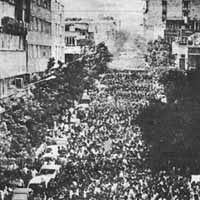
Over half a million supporters of the People’s Mojahedin Organization of Iran (PMOI / MEK Iran) march peacefully towards the Iranian parliament in Tehran to protest the suppression of fundamental freedoms in Iran. The demonstration was dispersed using live ammunition by the direct fatwa from Ruhollah Khomeini, the regime’s supreme leader. June 20, 1981.
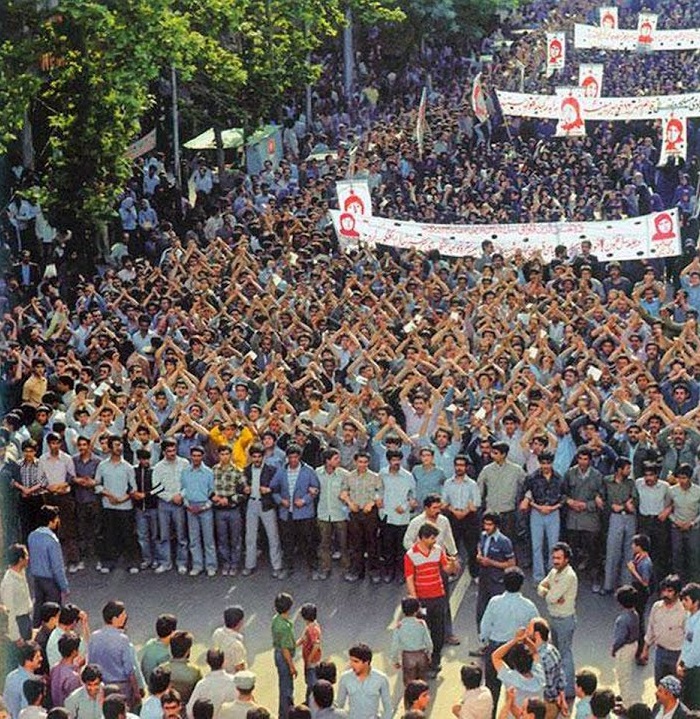
The “Mothers” demonstration, on May 2, 1981, when over 200,000 supporters of the MEK, took it to the streets of Tehran to protest the killing of 2 teenage girls (MEK supporters), who were shot dead for distributing information behind a stand in one of the streets in Mazandaran.
The Islamic revolution seemed to be on its last leg when, in late September, Iraqi military forces invaded Iran. This invasion breathed new life into the revolution. Iranians everywhere rallied to a call to arms. MEK members rushed to the battlefront to defend the country against the Iraqi invaders. (see www.mulahswar.com for more details)
Khomeini used the conflict as an opportunity to quell domestic opposition, arguing that all challenges to the ruling mullahs should be disregarded because of the war. Iraqi troops initially penetrated deep into Iranian territory, but beginning in January 1981, military forces in Iran mounted a series of successful counterattacks, turning the course of the war.
At home, the MEK continued its campaign for democracy and freedom. On April 24, 1981, the Mojahedin organized a demonstration against the killing of its members and sympathizers. More than 150,000 people took part in the rally.
June 20, 1981, marked a turning point. MEK Iran organized massive rallies in cities across the country, including Tabriz, Rasht, Amol, Qiyamshahr, Gorgan, Babolsar, Zanjan, Karaj, Arak, Isfahan, Rirjand, Ahwaz, and Kerman.8 A half-million Iranians attended the demonstration in Tehran to protest the mullahs’ tyrannical policies.
Khomeini responded by ordering Revolutionary Guards (IRGC) and Hezbollah to crack down on the Mojahedin. Thugs blocked off streets and then shot into the crowds departing the rally, killing hundreds and injuring many more.
“Prominent clerics declared that demonstrators, irrespective of their age, would be treated as ‘enemies of God’ and as such would be executed on the spot. Hezbollahis were armed and trucked in to block off the major streets. Pasdars [members of the Revolutionary Guards-IRGC] were ordered to shoot. Fifty were killed, 200 injured, and 1,000 arrested in the vicinity of Tehran University alone….The reign of terror had begun.”9
The next day hundreds of people who had been arrested were executed by Khomeini’s regime, including 12 young girls whose identities were unknown. The authorities published their pictures in the daily newspaper, Ettela’at, asking their parents to claim the bodies.10
The mullahs murdered 71 MEK Iran members, and another 2,500 were arrested and imprisoned before June 22. In the following months and years, more than 100,000 MEK members and supporters were killed by Khomeini and the ruling mullahs. Hundreds of thousands more were imprisoned and tortured.
Because of this bloodshed and brutality, the mullahs’ lost legitimacy with the people of Iran. It is now a fascist regime with ambitions to expand its borders throughout the world.
1 300 Hurt in Iran After Leftist Rally Leads to Rioting. The Globe and Mail. June 13, 1980.
2 Rouleau, Eric. Iranian Left and Right Slugging It Out in Chaotic Fighting. Le Monde. June 14, 1980.
3 Ibid.
4 Mohaddessin, Mohammad. (2004). Enemies of the Ayatollahs. London: Zed Books.
5 Khomeini Warns Iran of Leftist Threat. New York Times. June 17, 1980.
6 Mohaddessin, Mohammad. (2004). Enemies of the Ayatollahs. London: Zed Books.
7 Khomeini Demands Government Purge. New York Times. June 28, 1980.
8 Reported Hiding Out in Tehran. Associated Press. June 20, 1981.
9 Abrahamian, Ervand. (1989). The Iranian Mojahedin. New Haven, CT: Yale University Press.
10 Mohaddessin, Mohammad. (2004). Enemies of the Ayatollahs. London: Zed Books.
THE 1988 MASSACRE
In the summer of 1988, in the final days of the Iran/Iraq War, Ruhollah Khomeini issued a fatwa calling to execute all MEK members imprisoned in Iran. He appointed three-member Death Commissions to travel to the regime’s prisons to carry out the extra-judicial killings.
Throughout a single summer, the clerical regime executed 30,000 political prisoners, most of whom were MEK Iran (PMOI) members. Some of the people who were executed had already served their terms and were waiting to be released when the Death Commission arrived. The victims included teenagers, pregnant women, and the elderly. Many of the victims were tortured or raped before their deaths.
MASS EXECUTIONS AND UNMARKED GRAVES
Khomeini’s Death Commissioners held trials for the prisoners that lasted only minutes and consisted of a single question: Do you renounce the Monafeqin [a pejorative term for the MEK]? Those who answered no were executed in groups. The regime used cranes and gallows to hang MEK members and used firing squads to execute others. Bodies were piled in dump trucks and buried in unmarked mass graves across the country.
Family members were often not notified of their loved ones’ deaths or provided death certificates. Some families were summoned months later and given packets of their loved ones’ belongings but were denied information about the locations of their family members’ graves. Families were forbidden from holding memorial services or openly mourning their losses.
A CRIME AGAINST HUMANITY
To date, none of the perpetrators of the 1988 Massacre have been held accountable for this crime against humanity. Many of those responsible for sending MEK members to their deaths have since gone on to hold high-ranking positions within the regime, including the current Judiciary Chief, notorious Death Commissioner Ebrahim Raisi.
The regime still forbids families of the victims from holding public services in honor of their loved ones and refuses to reveal the locations of the mass graves where 30,000 MEK members are buried. The regime has gone to great lengths to conceal evidence of its crimes by paving over mass graves and constructing buildings and roads on top of them. The public is forbidden from discussing the massacre, but recently regime officials have publicly acknowledged the extra-judicial killings, claiming that the executions were justified and further vowing to exterminate the MEK.
MEK Iran (PMOI) and the NCRI have asked the United Nations to hold the regime accountable for its crimes against humanity. The MEK has raised awareness of this atrocity, forcing the international community to take notice and for world leaders and human rights groups to push for action.
Amnesty International has repeatedly joined the MEK in its call for an independent investigation into the 1988 Massacre
WITNESSES TO THE 1988 MASSACRE
In July 2019, witnesses to the 1988 Massacre told their stories at Ashraf-3, the MEK’s headquarters in Albania, at a five-day conference of world leaders. MEK members who were imprisoned in Iran during the massacre described the torture they endured at the hands of the regime.
Hengameh Haj-Hassan, a former nurse from Tehran, was arrested in 1981 for treating people who were wounded by the Revolutionary Guards (IRGC). She described being blindfolded and confined to a cage for months, with only enough room to squat. She was not allowed to move or make any sound, and she was continuously tortured and barely fed. At night her torturers played music over loudspeakers so that she could not sleep.
“The torturer told us that we would die here,” Ms. Haj-Hassan said, but she refused to be broken under torture. She was released before the 1988 Massacre and immediately rejoined the MEK.
Survivor Kobra Jokar was imprisoned for six years before finally escaping in 1986. She and her husband were tortured in front of each other, and her husband was later executed. Kobra was pregnant when she was arrested, and she was taken out of the medical center and sent back to her cell immediately after birth despite being very ill. Babies in prison were given no food or milk, and other women would provide the babies with their sugar rations to have something to eat. Pregnant women were executed.
“The torturers even interrogated the children,” said Ms. Jokar in her testimony. “They strapped a six-year-old girl to a chair in a dark room and said they would leave her there if she did not reveal the names of her mother’s friends.”
Although Ms. Jokar was able to escape prison, all of her cellmates were later executed in the 1988 Massacre.
CAMP ASHRAF AND CAMP LIBERTY
In 1986 the MEK moved its headquarters from France to Iraq. The location provided a strategic advantage, as it was close to Iran, and the large property allowed the MEK to create a camp the size of a fully-functioning small city. The headquarters, named Camp Ashraf, flourished as the MEK’s base of operations until the U.S. invasion of Iraq in 2003 when pressure from the mullahs led to several bombing attacks on the camp.
After the U.S. withdrawal from Iraq in 2009, the protection of MEK residents at Camp Ashraf was transferred to the new Iraqi government, headed by a Prime Minister with close ties to the Iranian regime. The MEK opposed the move, fearing for the safety of camp residents, but the transfer went ahead as planned. Camp Ashraf was attacked several times, and its residents were subjected to inhumane and illegal treatment.
In 2012, MEK Iran residents at Camp Ashraf were relocated to Camp Liberty, an abandoned military base in Iraq with substandard conditions. They were subjected to additional attacks and blockades, which prevented food, supplies, and medication from reaching camp residents.
SAFE RELOCATION OF MEK MEMBERS
That same year, the MEK, NCRI President-elect Ms. Maryam Rajavi, and a coalition of American, European, and Arab supporters, along with international human rights groups, began a campaign to find a new home for the MEK and to relocate all of the remaining residents of Camp Liberty to European countries. The resettlement process took almost five years and was completed on September 9, 2016, with the departure of the final 280 MEK members living at Camp Liberty.
The Iranian regime staged attacks on Camp Liberty until its final days. Weeks before the last MEK members departed for Albania, the terrorist Quds forces provided missiles to three proxy groups and directed them to attack the camp. On August 19, 2016, the Iraqi Federal Police found a truck belonging to the Kata’ib Hezbollah terrorist group loaded with explosives parked near Camp Liberty and stopped a bombing attack.
The mullahs used every weapon in their arsenal to prevent the MEK from relocating to a safer location. In addition to missile attacks, they gave red notices to Interpol and directed their proxies to issue fake arrest warrants to prevent MEK members from leaving Iraq. They used the same tactics to attempt to arrest MEK leaders and prominent members of the group. Ultimately, their efforts were in vain.
In a final petty act, the Iranian regime’s ambassador to Iraq prevented MEK Iran residents leaving Camp Liberty from taking their possessions with them. They were forced to leave behind their computers, cell phones, radios, and even their electric shavers. Although initially, residents were promised that their property would be sold, with the proceeds going to the MEK, the Iraqis later reneged on the deal. The original agreement, which was negotiated with an Iraqi merchant with the approval of the Iraqi government, was that the property would be sold for $10.7 million. Instead, the Iraqi government refused to sell more than 90% of the confiscated property and sold the rest at 25% of its market value.
ASHRAF-3
In 2016 the MEK broke ground on its new headquarters in Tirana, Albania, after a nearly five-year search for a new home. The base of operations, located on a patch of Albanian farmland and financed through donations from MEK supporters, was named Ashraf-3 and its residents Ashrafis.
In July 2019, former Albanian Prime Minister Pandeli Majko was one of 350 prominent political figures, human rights activists, and dignitaries from 47 countries to speak at a five-day conference at the newly-completed MEK headquarters. He explained why his government had chosen to host the MEK after they left Iraq.
“In 1943, the Nazis conquered Albania and had two main demands when an Albanian delegation went to Berlin,” Mr. Majko said. “They wanted our gold transferred to Berlin, and they wanted a list of all the Jews in Albania. Our answer was simple: the gold, yes; the Jews, no. Protecting those in need is part of our identity.”
In twenty months, the MEK (PMOI) members living at Ashraf-3 turned a piece of farmland into a small city, complete with a hospital, classrooms, conference halls, a museum, recreation centers, parks, restaurants, shopping centers, swimming pools, and a luxury hotel. 3,000 MEK members now live and work at Ashraf-3, where they work tirelessly to overthrow the Iranian regime and bring freedom and democracy to Iran.
Former New York Mayor Rudy Giuliani joked at the July 2019 conference about how quickly the compound had been constructed, saying, “If we tried to do this in New York, it would take 15 years and launch 14 corruption investigations.”
ASHRAF-3 WELCOMES DIGNITARIES
MEK Iran’s new location provides the opportunity for it to welcome visitors, whether they be foreign dignitaries or journalists. Since Ashraf-3’s construction, the MEK has welcomed dignitaries from hundreds of countries around the world to visit, tour the headquarters freely, and talk to MEK residents and ask questions. It has extended the same invitation to journalists. Those who have accepted this invitation have been greeted warmly and reported positively about their experiences at Ashraf-3.
Ashraf-3 is home to a museum dedicated to the MEK’s history and a wall of martyrs memorializing the 120,000 MEK members who have been killed by the Iranian regime. Visitors to Ashraf-3 learn about the 1988 Massacre and the many atrocities that have bound the MEK together as a group united in the struggle for freedom.
The July 2019 Free Iran Rally was held at Ashraf-3 and featured speeches, tours, panel discussions, and displays. Three hundred fifty high-ranking dignitaries from 47 countries spent five days reflecting on the MEK’s history, the current situation in Iran, and what must be done to support the MEK and the Iranian Resistance in their struggle to topple the mullahs.
The event was live-streamed on social media, allowing the world to see the MEK’s new home. The spotlight on the MEK has made it difficult for the regime to maintain its line that the MEK is secretive and cultish. Ashraf-3 has proven to be an excellent location for hosting guests, dispelling regime propaganda, and raising awareness of the regime’s crimes.
THE WORK BEING DONE AT ASHRAF-3
The MEK members living at Ashraf-3 have a variety of roles, but all Ashrafis have the goal of establishing a free Iran. While every member’s work is crucial, some of the most critical efforts in the fight to overthrow the mullahs are being waged by the members of the MEK research team.
These cyber warriors take video clips of protests that are smuggled out of Iran and use encrypted social media channels to broadcast them back to MEK supporters in Iran. Protests occur daily in Iran, but because of censorship, it is difficult and dangerous to share videos of the protests within the country, so people in Iran often don’t know what is going on in other cities. This has prevented the spread of resistance activity in the past. The MEK has found a way around this.
Members of the MEK research team teach MEK supporters inside Iran how to circumvent regime censorship to access the Internet and messaging apps. They also identify fake apps and spyware planted by the regime and share information on a channel on Telegram, a widely-used messaging app in Iran.
MEK Iran’s cyber warriors are some of the most effective soldiers in the fight for freedom from the mullahs. Iran has a young and tech-savvy population, and they make up a large part of the Iranian Resistance. With messaging apps and good encryption, MEK supporters in Iran can organize protests and spread information faster than the regime can shut them down.
The MEK Resistance Units have grown in size and influence because of their ability to organize on social media. Coordinated protests can occur in multiple cities at once, and people can receive calls to protest online. These acts of Resistance spread much more quickly than word of mouth, and they are almost impossible to prevent. Organized Resistance in Iran and cyber warriors in Albania are a combination that has so far been hard to beat.
The mullahs have not found a way to counter the MEK’s cyberwar and are unlikely to do so. During the November Uprising of 2019, the regime shut down the Internet entirely. However, photos and video clips still made it out of the country, and the world watched the rebellion unfold.
The regime has not ceased its attacks on the MEK. The Albanian government foiled a bombing attempt on Ashraf-3 in 2018, and the regime attempted other attacks the same year in Paris, The Netherlands, and the U.S.
Modern Islam
Though the MEK is a political organization, its orientation, operation, and support derives from its interpretation of Islam, which was conceived in its early years. MEK Iran believes that Islam is an inherently tolerant and democratic religion and is fully compatible with the values of modern-day civilization.
The Mojahedin believe that freedom, gender, ethnic and religious equality, human rights, and peace are more than just political commitments; they are ideological principles based on their view of the Quran and the traditions and teachings of Prophet Muhammad, Shiite Imams, and other leaders.
The MEK’s political platform and interpretation of Islam are one and the same. This combination makes the MEK unique amongst political groups, and it is a primary reason the organization continues today to amass broad public support.
The Shah feared the MEK because of its popularity and its commitment to democracy and human rights. The same holds for Iran’s mullahs. The clerics’ ideology, which is intolerant, extremist, genocidal, non-democratic, and misogynist, is directly opposed to the Mojahedin’s interpretation of Islam.
In 1982, Mr. Rajavi gave a speech discussing the MEK and Islam:
“The Islam we want is nationalistic, democratic, progressive, and not opposed to science or civilization. We believe there is no contradiction between modern science and true Islam, and we believe that in Islam, there must be no compulsion or dictatorship.”1
The following are some additional details of the MEK Iran’s interpretation of Islam.
Islam is Dynamic
Mr. Rajavi described the mullah’s interpretation of the Quran as mechanical and deterministic.2 In contrast, the MEK believes that genuine Islam is a dynamic faith that does not impede social progress. Islam does not oppose science, technology, and civilization, but cherishes and promotes them.
During Prophet Muhammad’s twenty-three-year mission, Quranic verses were sometimes declared mansouke (outdated). Some verses on social and economic matters changed in the early years of the Prophet’s rule, reflecting changes in society and advancements in culture and in social relationships. In the Prophet Muhammad’s later years, new verses were revealed to him that were more advanced with respect to these issues.
This explains why only 600 verses in the Quran (less than 10 percent) deal with edicts. The limited number of edicts shows that the Quran was not intended to replace the role of human beings to legislate for society and humankind. Instead, the Quran removed obstacles to social evolution. The Quran states that it came to remove the chains and shackles from human beings already subjugated by oppressive rulers and regimes.3 In doing so, humans could create a way of life consistent with their specific historical era, complete freedom, and consciousness.
Rules of Conduct and Edicts
Islam is an ideology with a comprehensive view on existence, society, and history, rather than a collection of edicts and rules of conduct on social, political, and economic matters.
Fundamentalists interpret the edicts, precepts, and temporal rules as unalterable dogma. At the same time, MEK Iran believes neither the Quran nor Islam support the claim that these rules are unchangeable and must be implemented at all times. Rather the Quran emphasizes that social and economic edicts must be designed for each era to prevent decadent, anti-counter-revolutionary forces from halting the advancement of human society.
The MEK believes that the rigid and reactionary interpretation of Islam, exemplified by Khomeini and fundamentalist clerics, is un-Islamic and runs contrary to the spirit of Islam.
Democracy
MEK Iran believes that democracy is essential to Islam. “Islam blossoms only in the spirit of freedom and truthfulness,” the MEK says, “and therefore cannot trample upon the legitimate rights of the people.”4
The Quran says that the attribute that most distinguishes humans from animals is their free will and individual responsibility. This is why humans are held accountable for their actions.5 Having a free will and right to choose is manifested in democracy, and a government by the people.
God’s will, as far as societies are concerned, has historically been realized through democratic governance. The Quran and the traditions of Prophet Muhammad and leaders such as Ali ibn Ali Taleb, the first Shiite Imam, emphasize the necessity of giving power to the people. Their teachings stress the need for progress, social and economic justice, and respect for human rights. References to these values are abundant in Islamic teachings, dating back fourteen centuries.
In contrast, fundamentalist mullahs reject the concepts of free will and individual choice. Democracy, in their opinion, is incompatible with Islam. MEK Iran (PMOI) disagrees and believes that spreading the word of God and Islam would be meaningless without freedom and respect for an individual’s free will and right to choose.
The Ballot Box
The MEK believes that the only criterion for political legitimacy is the ballot-box. The electorate, expressing itself in a free and fair election, gives a party, group, coalition, or individual the mandate to govern.
Fundamentalist mullahs believe in the concept of velayat-e faqih, which turns over the law, power, and legitimacy to a Supreme Leader. Such a clerical system is, by definition, totalitarian because it does not allow for freedom and the right to engage in political activity for anyone other than those who support an Islamic state.
Women’s Rights
Iranian women are the primary victims of religious dictatorship and dogma imposed by the mullahs. The clerical regime treats women as second-class citizens and denies them leadership positions, such as the presidency and judgeships.
Fundamentalist mullahs believe husbands should be able to divorce their wives at will and take custody of the child after the divorce. They believe fathers have the right to marry off their daughters to anyone they choose, and once she becomes an adult, she has no right to protest.
The MEK supports gender equality in all areas, from choosing a spouse and marriage to inheritance, testimony, custody, employment, and election to the highest positions in government. It is because of Ms. Rajavi’s advocacy that the issue of gender equality has become a central platform for the MEK.
Modern Islam
In 1980 Mr. Rajavi discussed the importance of freedom:
“Freedom is a divine blessing…Anyone trying to restrict human freedom has neither understood Islam nor humanity and the [anti-monarchist] revolution. Freedom is indispensable to the survival of humanity as human beings. Otherwise, human beings would be no different from animals and could not be held responsible for anything.”6
1 Mujahidin’s Masud Rajavi: ‘We are the only real threat to Khomeini.” MERIP Reports. March-April 1982.
2 Ibid.
3 Quran. Sura 7, Verse 157.
4 Mohaddessin, Mohammad. (2004). Enemies of the Ayatollahs. London: Zed Books.
5 Quran, Sura 2, Verse 256.
6 Mohahed (MEK Daily Newspaper). June 15, 1980.
[/vc_column_text][/vc_column][/vc_row]

